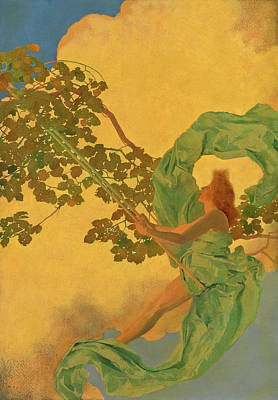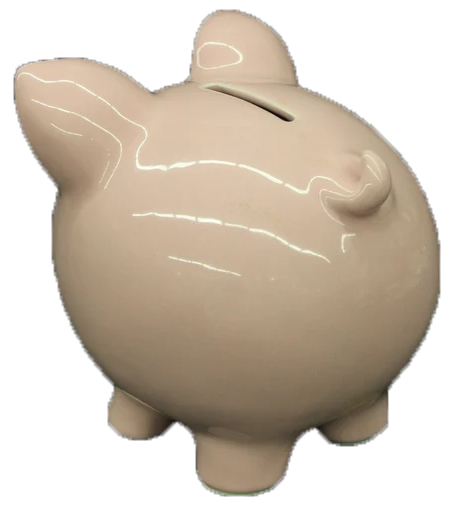golden investments
that can change your life
forever
Posted by Wendy Skog on August 25, 2022
During the first half of the 20th century poster art became extremely popular when households everywhere were decorated with neo-classical 'fantasy' prints by artist Maxfield Parrish. (eg. Girl on a Swing) Printed in enormous editions, they are still available as posters for under $20 and sold in malls and department stores today. A poster is not the same as a fine art print, which can be in the form of a hand-pulled silkscreen, lithograph, or block print. Or in today's world, a digital painting. In the print market, it is rarity that bestows value. An original in a limited edition series will always be worth more than a reproduction. These are worth collecting.
More important information about original prints

poster by Maxfied Parrish

I know what that is.
I think I know what that is.
Maybe it's a real painting.
I was studying a group of paintings in a public gallery when I came along two women huddled together in front of a piece. To my consternation I couldn't help overhearing the comment:
“Oh look it's an original giclee!"
This is a fine example of an oxymoron. There is no such thing as an original giclee. Giclee is a technology for fine art or photograph reproduction using an inkjet printer to make individual copies, usually in astronomic quantities. Giclee reproductions have become popular in the last few years mostly because people don't know what they are. Even if they are slickly reproduced on canvas which is now possible complete with texture, they are still reproductions Unless this kind of print is by a signature mega-artist they will probably never appreciate in value. Many experts see giclées as gimmicks.
But the comment made by one of the women above made me realize how difficult for the general art attendee and potential collector to know what they are looking at and if it is worth buying.

I was walking past a man in a Big Box Store who was putting a Big Box Store painting in a shopping cart. “Buy Original” I whispered loudly and recklessly in the direction of his ear. 'Buy original' is an art buying mantra for me. Whether it is a high schooler's creation for $100 or less, if it is original, and it makes you smile or gasp, it could be an enjoyable purchase.

What do the banks say about investing in art?
Contemporary artwork has outperformed the S&P 500 by a commanding 174% over the past 25 years, according to the Citi Global Art Market chart as reported by MoneyWise. I was doing some research on investing in art and was pleasantly shocked to see at least three front row banks that had a page on the benefits of investing in art. BMO points out "collecting art is proving to be one of the most fulfilling ways to grow your wealth". On the Royal Bank website we see their huge commitment to supporting the arts. And National Bank (NBC) announces “Investing in art is investing in a rich, diverse and prosperous market” And here are NBCs tips for desirable art investing through analysis and consideration of the artist's :
- Influence
- Public recognition in the art market
- Media recognition
- Their biography and professional background
- If their work has been part of a private or corporate collection, and whether it has been acquired by museums
- If the artist had any solo exhibitions, and with whom they have exhibited
In addition, I would add 'what is the method of production?' 'Is the artwork original?' 'Is it archival?' These are the most important factors in maintaining value, with the potential of increasing it.
show me the money
A growing number of wealth managers think art and collectibles should be part of an overall wealth management strategy, according to Deloitte’s Art & Finance Report. Why? Because in our present uncertain and tumultuous economy coupled with the highest inflation rates we’ve seen in 40 years, the stock market fluctuates like a bouncy rubber ball. You can lose everything in an hour. So tangibles are increasingly recommended such as fine art and antiquities acquisitions.
On July 30 2021, the G20 Ministers of Culture agreed for the first time in history on a G20 Declaration on Culture, which firmly positions culture as a major engine for sustainable socio-economic recovery in the wake of the COVID-19 pandemic. Corroborated by the best auction houses selling a couple billion dollars of art in a 2 week period.

Christie's auction house had the art world's first
$1 billion week back in 2015, a vast outpouring of money that amazed even the wealthy and the celebrities in the crowd.
But be assured, you don't need to be rich to invest in art.
join the crowd
Globally, aggregate sales by dealers and auctioneers reached $65.1 billion, soaring by 29% from 2020, according to the 2022 Art Basel and UBS Global Art Market Report, written by the cultural economist and founder of Arts Economics, Dr. Clare McAndrew.

anyone can be a collector
The fine art market continues to boom. "Collectors know exactly what they want from art: more. A lot more." -Wall street journal. Anyone can be a collector. A collector is usually someone who has spent a leisurely couple of hours or more trying to figure out the art market/art world and has some basic knowledge about the benefits of collecting art. It can be a having-your-cake-and-eating-it- too scenario: Collectors are able to fully and harmlessly 'consume' the art on their own wall for as long as wished and if it was a reasonably intelligent buy, probably reap a profit upon sending the artwork to the happy ever after secondary market. Visit my painting website for ideas!
time is on your side
When collecting art and antiquities time is the key. It's possible to generate positive returns from investing in art by being selective, diversifying your collection, and holding pieces for the long term. National Bank Canada recommends hedging your investment portfolio with high-quality real assets. When collecting art, if you like it and you are not being told you should like it, do a little research and see what it is exactly. And look up the artist's resume for further information. Be clear about what you're looking for: a poster, a glorified reproduction, an original archival print, a unique one off painting, and measure the asking price accordingly. And don't buy anything painted by a monkey or a robot.


"Tell me what you collect, tell me how you collect, and I will tell you who you are." - Jean Willy Mestach
See more blog stories on the blog page.
copyright 2022 All rights reserved W. Skog Fine Art Print Originals